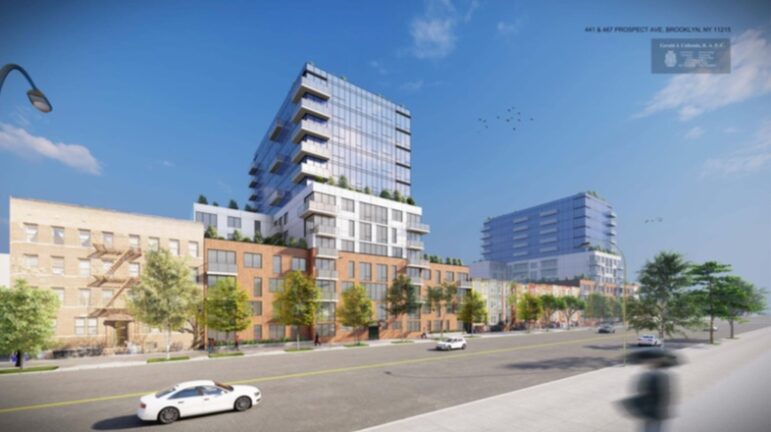“The greatest threat to Windsor Terrace’s character is not new development, but the status quo. If we continue to resist growth, we risk becoming an enclave accessible only to the wealthy, losing the diverse, family-friendly essence that makes our neighborhood special.”

Dept. of City Planning Documents
A rendering of the Arrow Linen site proposal.As a parent raising children in Windsor Terrace and a professional dedicated to strengthening communities and keeping families in their homes, I appreciate how special our neighborhood is and how challenging it has become for families to afford to live here. Windsor Terrace has long been a haven for families, offering a perfect blend of urban convenience and small-town community. With Prospect Park as our backyard, excellent schools within walking distance, and easy access to public transportation, it’s no wonder that demand for housing here has surged in recent years.
My family’s story is deeply intertwined with this community. Our children walked to the local elementary school every day, growing up alongside their peers. We’re fortunate to live a few blocks from my husband’s childhood home, allowing our kids to benefit from having grandparents nearby. This multi-generational connection to Windsor Terrace is emblematic of the strong community bonds that define our neighborhood.
However, this experience of a Windsor Terrace for families is under threat—not from development, as many of my neighbors believe, but from a lack of it.
In recent years, our neighborhood has seen a surge in housing demand, thanks to its notable proximity to transit, schools, and parks. But as demand has risen, housing supply has not kept up. Since 2015, neighborhoods on the east side of Prospect Park have built three times the number of homes that Windsor Terrace has. On many blocks in our neighborhood, the number of homes is actually shrinking as wealthier families purchase townhouses with multiple units and convert them into fewer units or even single-family homes.
The consequences are stark: since the pandemic, housing prices have skyrocketed by 30 percent, with family-sized units experiencing even steeper increases.
This failure to act is taking a toll on our community. I’ve lost count of the neighbors I’ve seen priced out, many forced to leave the city altogether in search of affordable housing. Parents should not be forced to choose between housing stability and a neighborhood that meets their family’s needs.
The proposed redevelopment of the Arrow Linen site on Prospect Avenue presents a valuable opportunity to start to address this crisis. The project would transform a sorely underused industrial space and parking lots into hundreds of homes for families near good schools and transit. Many of these homes will be subsidized, allowing low- and middle-income New Yorkers to experience the incredible quality of life Windsor Terrace provides. All of them will be served by elevators and wheelchair accessible, a rarity in our neighborhood with its old housing stock.
The research on housing cost is clear: building homes in a community mitigates housing costs. Further, it helps to maintain socioeconomic diversity, especially in high-demand areas. Windsor Terrace and South Slope are exactly the kinds of neighborhoods where we should be building new homes.
Moreover, this project furthers environmental sustainability goals. Building denser housing in areas well-served by public transit reduces the need for long commutes and decreases our carbon footprint. It’s a step towards sustainable urban planning, which is crucial in our fight against climate change.
The greatest threat to Windsor Terrace’s character is not new development, but the status quo. If we continue to resist growth, we risk becoming an enclave accessible only to the wealthy, losing the diverse, family-friendly essence that makes our neighborhood special.
Some opponents claim they support new housing, but only if it’s 100 percent affordable. This is a common tactic that opponents of all development employ to block any construction, knowing that 100 percent affordable projects are not financially feasible. Affordable housing often requires additional density to be economically viable and to maximize the number of affordable units created.
In order to preserve the Windsor Terrace we know, we must let it grow. Our community should support initiatives like the Arrow Linen redevelopment to ensure that our neighborhood remains a place accessible to families of all backgrounds.
Let’s choose inclusion over exclusion, growth over stagnation, and a vibrant future over a static past. By doing so, we can ensure that Windsor Terrace remains the perfect neighborhood for families—not just for those of us already here, but for generations to come.
Jessica Yager lives in Windsor Terrace with her family.








